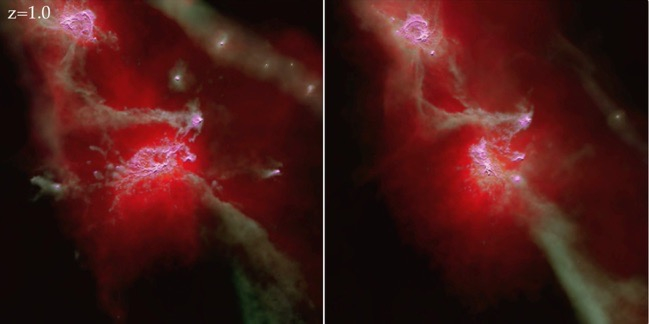Movies from the FIRE (Feedback In Realistic Environments) Project
These movies show simulations of individual galaxies forming, starting at a time when the Universe was just a a few million years old (redshift of 100). They follow the region that will become a single galaxy by the present time, tracing the evolution of dark matter and gas, which eventually turns into stars. Those stars then ‘light up’ the medium around them: they alter it with both their radiation heating up and pushing on the medium, as well as supernova explosions.
These are from the FIRE project: for more information, go to our project website here:
http://fire.northwestern.edu/
A Milky-Way Mass Galaxy in Formation (m12q)
These movies show the formation of a galaxy, similar in mass to the Milky Way, from early times (redshift z=100) to the present. The scale is fixed at 50 physical kiloparsecs on a side (so at early times, the galaxies occupy only a small fraction of this). Massive outflows driven by feedback from stars are plainly evident, and especially at early times have a dramatic impact on the surrounding inter-galactic medium. At later times, things “calm down” and a more relaxed disk starts to form.
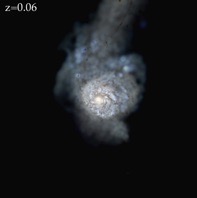
This shows a mock three-color image (u/g/r bands) of what this galaxy would look like in visible light wavelengths. Blue regions are young star clusters which have blown away the gas and dust out of which they formed. Red regions are obscured by large amounts of dust. (Compressed video)
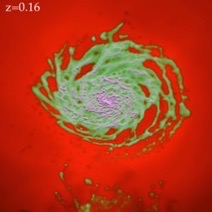
Gas:
This shows the gas in the galaxy. Magenta is cold molecular/atomic gas (T<1000 K), the stuff that forms stars. Green is warm ionized gas (10^4-10^5 K), most of the stuff cooling onto a galaxy. And red is ‘hot‘ gas (>10^6 K), making up the galaxy halo. (Compressed video)
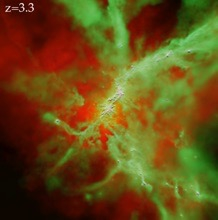
Gas (on larger scales)
This shows the gas from the same simulation, but on a larger scale (200 kpc, instead of 50). Here you can see much more of the structure of the surrounding inter-galactic medium - the “cosmic web” and how it is impacted by galactic winds. (Compressed video)
Gas and the Formation of Disks from the Cosmic Web: Face-on and Edge-on
Below, you can see movies of a simulation starting from slightly different initial conditions, with a different color scheme designed to highlight the cosmic web feeding the galaxies.
The Origin of Thin Galactic Disks (m12i)
These images show the disk of the present-day galaxy, in stars and gas, formed in our simulation with an “intermediate” history (at Milky-Way masses). We see a remarkably thin disk of young stars -- this is despite the violence of the outflows from the galaxy. It has been a challenge for decades to produce galaxies with thin disks, and some people have argued it may be incompatible with strong feedback -- but the parameters in these simulations are all identical, and the mass here agrees well with observations. Thin disks are possible, and compatible with strong feedback!
To make it easier to read, we show the full mock images of the stars (same style as the previous figure set), including the extinction by dust. But we also show an image where we don’t allow dust to attenuate the stars. Then you really see how thin the disk forming the young stars in the central few kiloparsecs of the galaxy can be. The images above link to full movies of the simulations, or you can download them here and here.
If you’re curious, here’s a picture of the gas in this galaxy, with the same style as above (magenta for cold/neutral gas, green for warm ionized gas, and red for hot gas). This links to a movie of the gas, on the same scale as the image and stellar movies above. For a movie of the gas on large scales, click here.
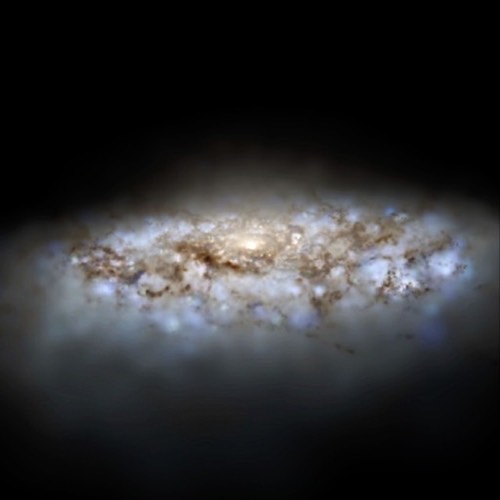
This series of movies shows the galaxy at present day, and “flies through” from the outskirts to the center and back again, so you can see all the structure. The different movies in the series show different observable quantities: what the galaxy would look like to the Hubble Space Telescope, or in X-rays, or if you could see different observational tracers of star formation and gas in the galaxy. Click and explore the possibilities.
A More Violent Alternative (m12v)
These movies are of a galaxy with similar mass, but one which experienced a more violent history. Unlike the previous system, this has many mergers -- violent collisions -- with other galaxies, over a wide range of times. As a result, the well-ordered disk we saw before never has as much chance to survive and grow before it is destroyed by these encounters. For some in-depth movies of what happens when two galaxies collide, click here.
Starlight (face-on and edge-on)
These show mock three-color image (u/g/r bands) of what this galaxy would look like in visible light wavelengths, like the movie above, from two different projections to help see the mergers clearly.
Gas (Temperature and Density Maps)
These show maps of the gas density (blue) and temperature (red, increasing from ~10^4 K in dark to ~10^6 K in bright red), in a box with fixed ~200 kpc physical size on a side. Feedback dramatically changes the structure of the inter-galactic medium.
This movie shows a (slightly different) simulation of the same initial conditions (using our new and improved GIZMO code). We see the gas (on 200 kpc scales, as in the movies at the top of this page) face-on and edge-on, and the stars as well in the same projections (zoomed-in to the same 50 kpc scales as before).
A Dwarf Galaxy in Formation (m10)
These movies compare, instead, the formation of a much smaller ‘dwarf’ galaxy, with a halo mass of 10^10 solar masses, and present-day mass in stars of a few million solar masses. Outflows are enormously important here -- the galaxy is a thousand times smaller in stellar mass than it would be without feedback! But feedback acts quite differently, as can be plainly seen. Outflows are very spherical, because the galaxy and its halo are small compared to the background filament it is forming out of. So accretion onto them is quasi-spherical. The outflows are primarily driven by warm/hot gas, in a series of ‘shells’. There isn’t much cold gas in the galaxy, because even a small mass in young, massive stars can heat up all the gas enough to ionize it and blow quite a large fraction out of the galaxy entirely!
You can also plainly see the effects of reionization at redshift z~8-9, when the Universe ‘lights up’ and the gas in the intergalactic medium becomes ionized.
These movies show the gas in the galaxy. Magenta is cold molecular/atomic gas (T<1000 K), green is warm ionized gas (10^4-10^5 K), and red is ‘hot‘ gas (>10^6 K).
Gas (large scales, 100 kpc on a side) Gas (small scales, 20 kpc on a side)
More Information About the Simulations:
In the absence of these ‘feedback’ effects, nearly 100% of the gas gravitationally bound to the final dark matter ‘halo’ would turn into stars, in stark disagreement with what is observed. But the movies plainly illustrate that feedback leads to massive galactic super-winds that blow out a great deal of the gas.
These simulations are focused on the cosmological scales around galaxies. To see movies illustrating how feedback regulates star formation and the structure of the interstellar medium within galaxies, click here.
These simulations explicitly follow these ‘feedback’ effects from stars in the form of radiation (radiation pressure, photo-ionization and photo-electric heating), stellar winds (both O-star and AGB), and supernovae (Types I & II). What does this mean?
- Radiation pressure: Light (mostly from the youngest stars) scatters off gas and dust in the galaxy. Each time a photon scatters or is absorbed, it imparts some of its momentum to that gas, “pushing” away the gas and dust. This does not “heat up” the gas, but can impart an enormous amount of momentum.
- Stellar winds: Young stars blow winds off their surface that can have velocities as large as ~1000 km/s. This shocks and provides a large amount of thermal energy to heat the gas. Older stars blow “slow” winds at just ~10 km/s, but the total mass recycled into the ISM can be very large, ~30% of the original mass in stars.
- Photo-Ionization: The light from the stars also ionizes gas, heating it up to ~10^4 K. These ionized ‘bubbles’ can push on the gas significantly in very low-mass galaxies (where the corresponding velocities of the gas are comparable to the disk orbital velocities). It can also destroy molecules, a critical ingredient for the next generation of star formation.
- Supernovae: After a few million years, massive stars begin to explode as supernovae. Each such event imparts a large energy to the nearby ISM. Many “overlapping” events can build up huge hot bubbles of gas that generate pressures sufficient to “blow out” of the disk and vent material into the intergalactic medium.
